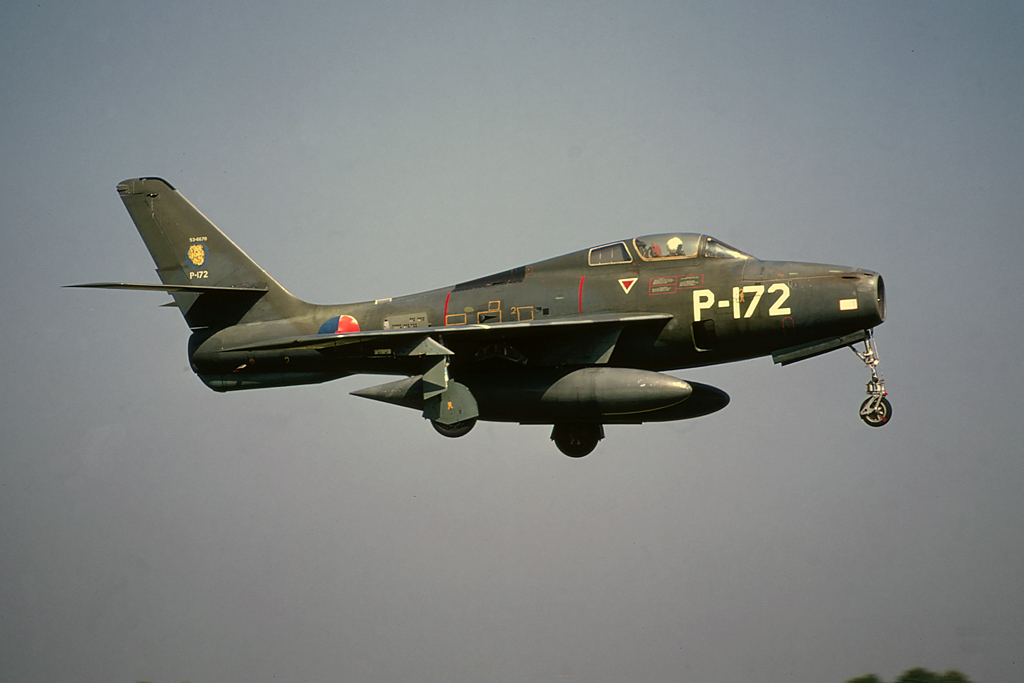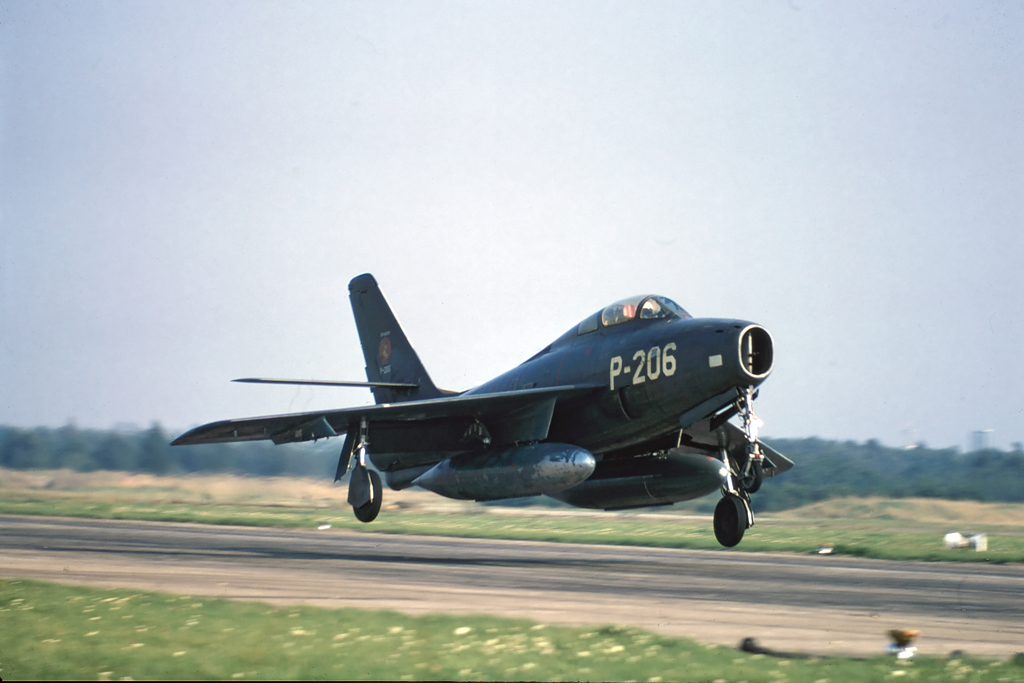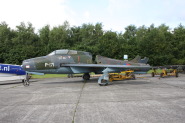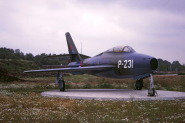|
|
|
|
|
|
Service history of the F-84F with the RNLAF
The Republic F-84F Thunderstreak was introduced in 1949, as a competitor
to North American Aviation's F-86 "Sabre". The "F" model differs from
the other models in that its wings are swept back forty degrees; its
tail and elevator are swept back and it has a smaller canopy and
redesigned windscreen. Although the Republic F-84F Thunderstreak was a modified
Republic F-84E Thunderjet, it only utilized fifteen percent of its ancestor's airframe. With the addition of swept wings and tail, and improved engines, the new aircraft matched anything flying in 1954.
The Republic F-84F Thunderstreak became the front line fighter bomber of NATO throughout the 1950's.
The original production schedule for the Republic F-84F Thunderstreak that was prepared in
August of 1950 called for the first deliveries to be made by the autumn
of 1951. But serious production problems with the airframe and the
engine delayed the delivery so badly that a straight-winged Republic
F-84G Thunderjet was developed as a stop-gap measure, the first Republic
F-84F Thunderstreak was delivered to the USAF at the end of 1952.

Delivery to the Royal
Netherlands Air Force
The delivery to the Royal Netherlands Air Force (Koninklijke Luchtmacht
or KLu) was a direct result of a decision that was made during a NATO meeting in in Lisbon in 1951 where it was decided that the
Royal Netherlands Air Force would create two tactical air wings operating the
Republic F-84 at first with the E and G model Thunderjet and on a later date with the
Republic F-84 F Thunderstreak. The wings would eventually be created at Volkel and Eindhoven air base, with the aircraft being delivered via the Mutual Defence Assistance Program (MDAP).
The Royal Netherlands Air Force received one
hundred and eighty
Republic F-84F Thunderstreaks via the MDAP with the first arriving in the Merwehaven at Rotterdam on the sixth of November 1955. These planes were transported by road to Avio-Diepen at air base Ypenburg for reassembly and flight testing. These transport occurred by night over the highway to minimise the impact on the traffic. A
hundred and three were delivered by cargo ships and aircraft carriers; the other
seventy seven were flown from the USA to the airbases of Volkel and Eindhoven via the so called "High Flight"
route.
In the first years of their operational life the Royal Netherlands Air
Force Republic F-84F Thunderstreak were
painted silver. They all got a registration, beginning with P-. As the
Republic
RF-84F Thunderflash were registered as P-1 to P-24, the Republic F-84F
Thunderstreaks started with P-101. It seems to be logical that the last registration
had to be P-280, but due to a mistake the registration were P-101 to
P-277 and P-298 to P-300.
In the fifties the Royal Netherlands Air Force used the British system of squadron codes; each
squadron within the West European Union had its own unique code. For
example, 311 squadron at Volkel used PP-, so the second delivered
Republic F-84F Thunderstreak got the code PP-2 on the nose and the registration (P-121)
and USAF serial number (52-7189) on the tail. When an aircraft changed
squadron, the squadron code had too be changed as a result, so most of
the Republic F-84F Thunderstreaks have used several different squadron codes.
The First squadron to resave the Republic F-84F Thunderstreak was 311 squadron in November 1953.

Operational history
311 squadron was the first to be operational with the Republic F-84F
Thunderstreak . The first Aircraft, registered P-103, was delivered November 29, 1955; the last and 25th
Republic F-84F Thunderstreak , registered P-239, was delivered June 20, 1956.
In March 1956 the first Republic F-84F Thunderstreak s were delivered to 312 and 313 squadron. 312 squadron received the last
Republic F-84F Thunderstreak , registered P-235, June 12, 1956.
March 9, 1955 313 squadron received the first Republic F-84F Thunderstreak , P-214. because of delay of the delivery of the rest of the aircraft, eight examples were loaned from 312 squadron, so the Thunderjet could be withdrawn from use.
At the end of 1956 the last Republic F-84F Thunderstreak for 313 squadron were delivered, so its strength was 25 aircraft.
314 squadron received its first Republic F-84F Thunderstreak , registered P-212,/8T-25 on may 1, 1956; its last example, P-161, was delivered just three months later. 314 squadron was part of the so called Allied Command Europe Mobile Forces (ACEMF) and was on a regular basis detached in Denmark and Norway.
April 28, 1956 the first Streak , P-205 for 315 squadron arrived. In September the squadron received its 27th and last
Republic F-84F Thunderstreak.
In the meantime two Streaks were written off due to accidents. May 1970 315 squadron was moved to air base Twenthe for the conversion to the Canadair NF-5 Freedom Fighter . The remaining
Republic F-84F Thunderstreak s were handed over to 314 squadron.
July 27, 1956 the first three Streaks, P-157, P-166 and P-186 were delivered to 316 squadron; the last one was delivered in 1957. January 1958 the squadron was abolished, because due to accidents twenty-two
Republic F-84F Thunderstreak s had been written of and over thirty aircraft were in maintenance. The aircraft of the squadron were handed over to the other squadrons.
June 1958, 313 squadron was merged with the Jacht Vlieg School. Its
Republic F-84F Thunderstreak s were handed over to the other four CTL squadrons (Commando Tactische Luchtstrijdkrachten = Tactical Command).
Squadrons 311 and 312 squadron converted to the Lockheed F-104G Starfighter in 1964 - 1965. One hundred and fifteen
Republic F-84F Thunderstreak s were left for two squadrons.
These Republic F-84F Thunderstreak were of different modification standards, so it was decided to withdraw the
Republic F-84F Thunderstreak 60-RE and earlier. On demand of the US twenty of these aircraft were handed over to Turkey. In 1970 both squadrons exchanged their
Republic F-84F Thunderstreak s for the Northrop Canadair NF-5 Freedom Fighter.
Show aircraft.
Despite it poor flying capabilities the Republic F-84F Thunderstreak was used by
several display teams, such as the famous US team ‘Thunderbirds’.
Also in the Netherlands several display teams used the Republic F-84F
Thunderstreak ,
such as the "Dash Four" team of 1956 and the “Red Noses-team.
In 1963 there was a team of 315 squadron “Sandbag Diamond” with four
Republic F-84F Thunderstreak s plus one solo. Very little is known about this team.
A well known team, which never flew an official display was the “Whiskey
Four 67" of squadron 314. Seven aircraft had the special scheme applied.
Because of an accident killing the pilot during a training flight the
team was dismissed shortly before its first official display.
In 1970 314 squadron raised a team, called "The Rascals" which displayed
several times. In 1971 the team flew with the successor of the
Republic F-84F Thunderstreak , the Northrop Canadair NF-5 Freedom Fighter.
Squadrons equipped with the Republic F-84F Thunderstreak
|
|
311 squadron
In preparation for the arrival of MDAP Thunder-jets, the airfield at
Volkel, which had been constructed during the war to house Luftwaffe
units, was rebuilt during 1950 and handed over to the
Luchtstrijdkrachten (LSK) on 3 April 1951. At this time, four F-84E
Thunderjets were on strength, and on 1 May these formed 311 Squadron,
with 'PP- ' codes. Deliveries progressed slowly, and by September 18 had
been delivered. Seven transferred to 312 Squadron in January 1952, but
between April and June 311 Squadron re-equipped with the F-84G (serials
K-22 to K-40), and their remaining E variants were withdrawn for
conversion to reconnaissance configuration.
Republic F-84F Thunderstreak s began to arrive in Holland in mid-1955, and once they had
been assembled the first batch was handed over by the US Ambassador on 9
December, with 311 Squadron as the recipient. In the days of the
Thunderjet, 311 Squadron had flown an aerobatic team, the 'Skyblazers',
only a few months after receiving their first aircraft, and this
precedent was followed by the 'Dash 4' team, established early in 1956.
The four aircraft gave their first public display at an open day at
Soesterberg, and later in the year went on to win an aerobatic
competition at Las Vegas, Nevada.
With the exception of the British and American air forces, the remainder
of NATO's aircraft strength was restricted to operations in the
conventional role. However, on 1 July 1960, 311 Squadron became the
first tactical nuclear strike unit outside of these two air arms,
carrying the atomic weapon in place of one external fuel tank for
release in a LABS manoeuvre.
Retirement for the Republic F-84F Thunderstreak s was signalled by the arrival of the
first Starfighters at Volkel in June 1964. On September the 18th 1965
the last four Republic F-84F Thunderstreak s of 311 squadron were transferred to
Eindhoven AB, marking the end of this type with 311 Squadron.
|
|
312 Squadron
The second Thunderjet squadron in the Luchtstrijdkrachten, 312 formed on
1 December 1951 and its first seven aircraft transferred from 311
Squadron, also at Volkel, the next month. The code letters 'DU- ' were
allocated to the new equipment, together with the radio call sign 'Bonzo'.
G versions of the Thunderjet soon arrived with 312 Squadron and remained
in use until 1956.
In Januari of 1955 the squadron started its conversion to the Republic
F-84F Thunderstreak . On 3 April 1956, the squadron made its first
Republic F-84F Thunderstreak flight
and returned its 'Jets to the USAF. Together with its sister squadron,
311 it formed a joint aerobatic team which existed until 1958.
Following the absorption of 313 Squadron into the Jachtvliegeropleiding
(JVO), the F-84F Operationele Conversie Curses (Operational Conversion
Course) was transferred to 312 Squadron in January 1959, where it
remained until October 1961, when 315 Squadron took on the task.
Having previously been one of the first squadrons to accept any new
equipment, 312 was the last Royal Netherlands Air Force unit to convert to the Starfighter
(mostly second-hand examples from other units), and transferred its last
'Streaks to Eindhoven on 1 December 1965. |
|
313 squadron
The history of 313 squadron traces back to 1952 when the first T-33
T-birds where delivered to Volkel AB. At first as a base flight but as
the number of aircraft being used grew the flight was transformed in 311
squadron on the first of December 1953 at Volkel AB.
In the first period the squadron operated a mix of aircraft consisting
off, the T-33 T-bird , Harvard and some F-84G Thunderjets. As more
Republic F-84F Thunderstreak 's
come available 313 squadron exchanged its Republic F-84G Thunderjets for the newer type in
1956. With the centralisation of the jet training at Woensdrecht
AB the squadrons also makes the move to Woensdrecht AB in 1958, during
this transition the Republic F-84F Thunderstreak 's are transferred to 312
Squadron. At the end of the year when the squadron has transferred its
remaining aircraft to the "Jachtvliegopleiding" it is dissolved at the
first of January 1959
The squadron was re-established at Twenthe AB on 12-10-72, flying the
Canadair NF-5 Freedom Fighter in the training role it took over, from the 315 Squadron. This made
the squadron responsibility for the operational conversion of pilots returning from
advanced training in the USA and Canada with Theatre Operational
Conversions Courses (TOCC) followed by Advanced Operational Courses (AOC)
to adjust to European operations (weather) and weapons usage.
|
|
314 Squadron
Created in 1952 at Eindhoven AB the squadron started on the F-84G
Thunderjet with four aircraft in the beginning the strength steadily
grew as more aircraft where delivered till the squadron was on strength
with twenty-five aircraft in 1953.
The first Republic F-84F Thunderstreak 's where delivered to the squadron in 1956
at the moment the squadron started its transition to the new type. In
this year the squadron delivered many of its F-84G Thunderjet to
NATO allies like Portugal and Turkey , the last flight of a F-84G
Thunderjet was made on August the 23th 1956 during a flight to Ypenburg
AB.
During 1956 the last of the twenty-five Republic F-84F Thunderstreak 's for the
squadron was delivered and the squadron was fullt operational on the
Republic F-84F Thunderstreak 's. In de following years the squadron would become
part of the Allied Command Europe Mobile Force resulting in the first
rotation to Norway in 1959 with many to follow.
At the moment of the introduction of the Canadair NF-5 Freedom Fighter the squadron was part of
the NATO Allied Mobile Force and deployed with the Republic F-84F
Thunderstreak 's for the
last time in January 1970.
The arrival of the Canadair NF-5 Freedom Fighter started the withdrawal
off the Republic
F-84F's witch was officially withdrawn from service on the 21th of
December 1970.
|
|
315 Squadron
Formed at Eindhoven on 25 June 1952 as the second of three Thunderjet
squadrons in the local wing, with 25 aircraft coded 'TB- '. In 1956 the
squadron followed the lead set by 314 Squadron and re-equipped with
Thunderstreaks, disposing of its last Thunderjet on 23 August 1956.
The unit took up a training role on 1 October 1961, when a joint intake
of Belgian and Dutch pilots heralded the commencement of a unified
training scheme, whereupon 315 Squadron took over the five-month
Operational Conversion Course (OCC) from 312 Squadron. Under the mutual
scheme (see VVS, 'Belgian Military Aviation' page 37), basic training
was given at Gilze-Rijen (NL) and Goetsenhoven (B), after which the two
streams merged to pass through Brustem (B), Woensdrecht (NL), and
ultimately Eindhoven. Types used were the Fokker S.1 1, Stampe SVAB/C,
Fouga Magister, T-33A and F-84F.
Large-scale use of the Thunderstreak ensured a rapid flow of pupils
through Eindhoven, one new course every five months.
When in 1965 311 and 312 Squadrons at Volkel received Starfighters, the
Thunderstreaks of 314 and 315 Squadrons (all 1952 vintage) were returned
to the USAF for the use of other NATO countries, and the newer (1953)
Volkel examples went to 315 and 316 in their stead. Replacement came at
last in December 1969, when the first Canadair NF-5 Freedom FighterB arrived at Twenthe, and 315
left its Thunderstreaks at Eindhoven on 1 May 1970 to take up residence
at its new home.
The squadron was given the responsibility of being the F-5A training
unit, prior to 313 Squadron at the same base adopting the task.
|
|
316 Squadron
With the establishment of 316 squadron in 1953 at Eindhoven AB the local
wing was completed , operating twenty-five F-84G Thunderjets coded from
'TC-1' upwards, and functioning as a "maandvlieg" reserve squadron,
tasked with keeping former pilots "airworthy".
Although disbanded in March 1955, 316 Squadron was reactivated on 1
August 1956, this time as a regular unit with the F-84F Thunderflash,
which it flew until deactivated on 15 January 1958. This premature
disbandment was in order to keep the other units flying the F-84F
Thunderflash up to strength, as twenty of the type had already been
written off.
In May 1971, 314 Squadron and its Canadair NF-5 Freedom FighterAs left Eindhoven for Gilze-Rijen,
where on 1 June it was split to form a new 316 Squadron. After
transferring to Eindhoven, the squadron continued to work up on its
allocation of twenty-two NF-GA and six Canadair NF-5 Freedom FighterB, but made a permanent move
back to Gilze-Rijen on 27 April 1972, becoming operational there the
next year.
|
|
End of the line
|
End of the line
|
|
|
 |
 |
|
|
The F-84Fs were phased out of Dutch
services in two batches. The first half involved the Streaks of 311 and
312 squadron at Volkel. From October 1964 onwards these squadrons
started converting to the Starfighter and this was completed by the end
of 1965. Their Republic F-84F Thunderstreak s were either returned to the USAF (and
subsequently sent to Greece and Turkey), taken in use for spareparts/decoy
purposes or transferred to 314 and 315 squadrons at Eindhoven.
At Eindhoven the type remained in service till 1970, when the conversion
to the Northrop Canadair NF-5 Freedom Fighter was completed. The majority of the Republic F-84F
Thunderstreak s
where scrapped. A number of them was allowed to stay in Holland mainly
for decoy and museum purposes, and some 20 aircraft were transferred to
Greece where they soldiered on till the early 1980
The last operational flight with a Dutch F-84F was December 21, 1970.
Because of accidents 75 aircraft were written off during the fourteen
years the Streak had been used. This is almost 42 % of the total amount
of Republic F-84F Thunderstreaks used in Dutch service.
After their operational service about 30 Streaks were temporarily used
as eye-catchers (“decoys”) at air-bases of the Royal Netherlands Air
Force: about 4 aircraft
were present at each airfield. They were removed and scrapped in 1980. A
few Dutch F-84F’s still survive today as gate-guards, monuments
,instructional airframes or museum aircraft
|
|
|
|
|
|
|
|
|
|
 |
|
|